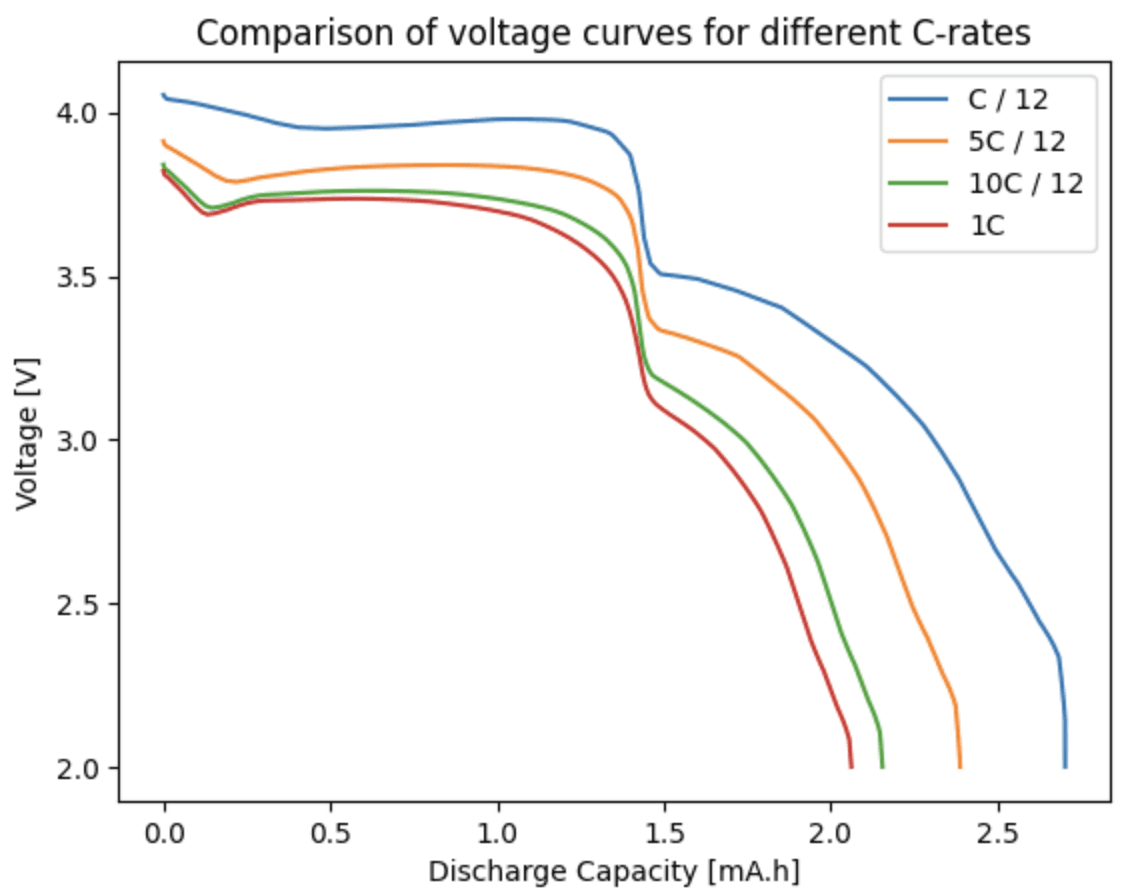Apr 8, 2025
Apr 8, 2025
When Batteries Age: Understanding Degradation & State of Health (SoH)
When Batteries Age: Understanding Degradation & State of Health (SoH)

Batteries, like all engineered systems, don’t last forever. Over time, they gradually lose capacity, efficiency, and power output—a process known as battery degradation or aging. This decline in performance affects everything from electric vehicle range to smartphone battery life. In our previous post, we explored how heat generation and thermal models play a crucial role in battery performance. One of the most significant consequences of elevated temperature is its impact on battery degradation, but temperature is just one piece of the puzzle.
Battery degradation occurs due to a combination of physical and chemical changes within the cell. Repeated charge and discharge cycles, extreme operating temperatures, and even just the passage of time all contribute to the aging process. Typically, aging is classified into two categories: cycling aging and calendar aging. Cycling aging refers to degradation caused by the battery’s operation—charging and discharging over time. Calendar aging, on the other hand, occurs simply due to the passage of time, even if the battery is sitting on a shelf unused. Some key degradation mechanisms include the growth of the solid electrolyte interphase (SEI), lithium plating, and loss of active material. While we’ll explore these mechanisms in detail in an upcoming post, what matters practically is how we measure and quantify battery health.
This is where State of Health (SoH) comes in. SoH is a metric that quantifies how much a battery has degraded compared to its original state. It is typically expressed as a percentage, with 100% representing a brand-new battery and lower values indicating reduced capacity or performance.
There are different ways to define and measure SoH, depending on the application:
Capacity-based SoH: The most common definition, this measures how much of the original capacity remains. For example, if a battery was originally rated for 100 Ah and now delivers only 80 Ah, its SoH is 80%. This is measured under specific discharge conditions, and different conditions may yield different SoH measurements.
Resistance-based SoH: Since internal resistance increases with aging, some methods estimate SoH by tracking the rise in resistance over time. Higher resistance leads to greater energy losses and reduced power output.
Model-based SoH estimation: Advanced battery management systems (BMS) use a combination of real-time data, historical usage patterns, and electrochemical models to estimate SoH dynamically.
Monitoring SoH is crucial for ensuring reliable battery operation. In consumer electronics, a lower SoH means shorter battery life. In electric vehicles, it affects driving range and charging speed. In grid storage, it influences energy availability and system efficiency. Knowing when a battery has reached an unacceptable SoH threshold helps determine when it should be replaced, repurposed, or recycled.
Understanding battery degradation is key to extending battery lifespan, improving reliability, and designing better energy storage systems. In our next post, we’ll take a closer look at the mechanisms behind battery aging—the microscopic processes that drive capacity fade and power loss over time.
Batteries, like all engineered systems, don’t last forever. Over time, they gradually lose capacity, efficiency, and power output—a process known as battery degradation or aging. This decline in performance affects everything from electric vehicle range to smartphone battery life. In our previous post, we explored how heat generation and thermal models play a crucial role in battery performance. One of the most significant consequences of elevated temperature is its impact on battery degradation, but temperature is just one piece of the puzzle.
Battery degradation occurs due to a combination of physical and chemical changes within the cell. Repeated charge and discharge cycles, extreme operating temperatures, and even just the passage of time all contribute to the aging process. Typically, aging is classified into two categories: cycling aging and calendar aging. Cycling aging refers to degradation caused by the battery’s operation—charging and discharging over time. Calendar aging, on the other hand, occurs simply due to the passage of time, even if the battery is sitting on a shelf unused. Some key degradation mechanisms include the growth of the solid electrolyte interphase (SEI), lithium plating, and loss of active material. While we’ll explore these mechanisms in detail in an upcoming post, what matters practically is how we measure and quantify battery health.
This is where State of Health (SoH) comes in. SoH is a metric that quantifies how much a battery has degraded compared to its original state. It is typically expressed as a percentage, with 100% representing a brand-new battery and lower values indicating reduced capacity or performance.
There are different ways to define and measure SoH, depending on the application:
Capacity-based SoH: The most common definition, this measures how much of the original capacity remains. For example, if a battery was originally rated for 100 Ah and now delivers only 80 Ah, its SoH is 80%. This is measured under specific discharge conditions, and different conditions may yield different SoH measurements.
Resistance-based SoH: Since internal resistance increases with aging, some methods estimate SoH by tracking the rise in resistance over time. Higher resistance leads to greater energy losses and reduced power output.
Model-based SoH estimation: Advanced battery management systems (BMS) use a combination of real-time data, historical usage patterns, and electrochemical models to estimate SoH dynamically.
Monitoring SoH is crucial for ensuring reliable battery operation. In consumer electronics, a lower SoH means shorter battery life. In electric vehicles, it affects driving range and charging speed. In grid storage, it influences energy availability and system efficiency. Knowing when a battery has reached an unacceptable SoH threshold helps determine when it should be replaced, repurposed, or recycled.
Understanding battery degradation is key to extending battery lifespan, improving reliability, and designing better energy storage systems. In our next post, we’ll take a closer look at the mechanisms behind battery aging—the microscopic processes that drive capacity fade and power loss over time.
Batteries, like all engineered systems, don’t last forever. Over time, they gradually lose capacity, efficiency, and power output—a process known as battery degradation or aging. This decline in performance affects everything from electric vehicle range to smartphone battery life. In our previous post, we explored how heat generation and thermal models play a crucial role in battery performance. One of the most significant consequences of elevated temperature is its impact on battery degradation, but temperature is just one piece of the puzzle.
Battery degradation occurs due to a combination of physical and chemical changes within the cell. Repeated charge and discharge cycles, extreme operating temperatures, and even just the passage of time all contribute to the aging process. Typically, aging is classified into two categories: cycling aging and calendar aging. Cycling aging refers to degradation caused by the battery’s operation—charging and discharging over time. Calendar aging, on the other hand, occurs simply due to the passage of time, even if the battery is sitting on a shelf unused. Some key degradation mechanisms include the growth of the solid electrolyte interphase (SEI), lithium plating, and loss of active material. While we’ll explore these mechanisms in detail in an upcoming post, what matters practically is how we measure and quantify battery health.
This is where State of Health (SoH) comes in. SoH is a metric that quantifies how much a battery has degraded compared to its original state. It is typically expressed as a percentage, with 100% representing a brand-new battery and lower values indicating reduced capacity or performance.
There are different ways to define and measure SoH, depending on the application:
Capacity-based SoH: The most common definition, this measures how much of the original capacity remains. For example, if a battery was originally rated for 100 Ah and now delivers only 80 Ah, its SoH is 80%. This is measured under specific discharge conditions, and different conditions may yield different SoH measurements.
Resistance-based SoH: Since internal resistance increases with aging, some methods estimate SoH by tracking the rise in resistance over time. Higher resistance leads to greater energy losses and reduced power output.
Model-based SoH estimation: Advanced battery management systems (BMS) use a combination of real-time data, historical usage patterns, and electrochemical models to estimate SoH dynamically.
Monitoring SoH is crucial for ensuring reliable battery operation. In consumer electronics, a lower SoH means shorter battery life. In electric vehicles, it affects driving range and charging speed. In grid storage, it influences energy availability and system efficiency. Knowing when a battery has reached an unacceptable SoH threshold helps determine when it should be replaced, repurposed, or recycled.
Understanding battery degradation is key to extending battery lifespan, improving reliability, and designing better energy storage systems. In our next post, we’ll take a closer look at the mechanisms behind battery aging—the microscopic processes that drive capacity fade and power loss over time.
Batteries, like all engineered systems, don’t last forever. Over time, they gradually lose capacity, efficiency, and power output—a process known as battery degradation or aging. This decline in performance affects everything from electric vehicle range to smartphone battery life. In our previous post, we explored how heat generation and thermal models play a crucial role in battery performance. One of the most significant consequences of elevated temperature is its impact on battery degradation, but temperature is just one piece of the puzzle.
Battery degradation occurs due to a combination of physical and chemical changes within the cell. Repeated charge and discharge cycles, extreme operating temperatures, and even just the passage of time all contribute to the aging process. Typically, aging is classified into two categories: cycling aging and calendar aging. Cycling aging refers to degradation caused by the battery’s operation—charging and discharging over time. Calendar aging, on the other hand, occurs simply due to the passage of time, even if the battery is sitting on a shelf unused. Some key degradation mechanisms include the growth of the solid electrolyte interphase (SEI), lithium plating, and loss of active material. While we’ll explore these mechanisms in detail in an upcoming post, what matters practically is how we measure and quantify battery health.
This is where State of Health (SoH) comes in. SoH is a metric that quantifies how much a battery has degraded compared to its original state. It is typically expressed as a percentage, with 100% representing a brand-new battery and lower values indicating reduced capacity or performance.
There are different ways to define and measure SoH, depending on the application:
Capacity-based SoH: The most common definition, this measures how much of the original capacity remains. For example, if a battery was originally rated for 100 Ah and now delivers only 80 Ah, its SoH is 80%. This is measured under specific discharge conditions, and different conditions may yield different SoH measurements.
Resistance-based SoH: Since internal resistance increases with aging, some methods estimate SoH by tracking the rise in resistance over time. Higher resistance leads to greater energy losses and reduced power output.
Model-based SoH estimation: Advanced battery management systems (BMS) use a combination of real-time data, historical usage patterns, and electrochemical models to estimate SoH dynamically.
Monitoring SoH is crucial for ensuring reliable battery operation. In consumer electronics, a lower SoH means shorter battery life. In electric vehicles, it affects driving range and charging speed. In grid storage, it influences energy availability and system efficiency. Knowing when a battery has reached an unacceptable SoH threshold helps determine when it should be replaced, repurposed, or recycled.
Understanding battery degradation is key to extending battery lifespan, improving reliability, and designing better energy storage systems. In our next post, we’ll take a closer look at the mechanisms behind battery aging—the microscopic processes that drive capacity fade and power loss over time.


12 Days of Electrochemical Testing
To celebrate the holiday season and the re-release of Ionworks Studio, we featured "12 (business) days of electrochemical testing". Each day we pick a test, give a little bit of information about it, and show you how to run it in Ionworks. 🔋 🎄
Dec 17, 2024


12 Days of Electrochemical Testing
To celebrate the holiday season and the re-release of Ionworks Studio, we featured "12 (business) days of electrochemical testing". Each day we pick a test, give a little bit of information about it, and show you how to run it in Ionworks. 🔋 🎄
Dec 17, 2024


12 Days of Electrochemical Testing
To celebrate the holiday season and the re-release of Ionworks Studio, we featured "12 (business) days of electrochemical testing". Each day we pick a test, give a little bit of information about it, and show you how to run it in Ionworks. 🔋 🎄
Dec 17, 2024


Sodium Ion Battery Model now available in PyBaMM!
This blog post explores the history of SIBs, the intricacies of the new PyBaMM model, and the exciting possibilities it unlocks for the future of energy storage.
Nov 12, 2024


Sodium Ion Battery Model now available in PyBaMM!
This blog post explores the history of SIBs, the intricacies of the new PyBaMM model, and the exciting possibilities it unlocks for the future of energy storage.
Nov 12, 2024


Sodium Ion Battery Model now available in PyBaMM!
This blog post explores the history of SIBs, the intricacies of the new PyBaMM model, and the exciting possibilities it unlocks for the future of energy storage.
Nov 12, 2024


Ionworks Presents at International Battery Seminar
Ionworks CEO Valentin Sulzer presents at the International Battery Seminar in Florida
Mar 12, 2024


Ionworks Presents at International Battery Seminar
Ionworks CEO Valentin Sulzer presents at the International Battery Seminar in Florida
Mar 12, 2024


Ionworks Presents at International Battery Seminar
Ionworks CEO Valentin Sulzer presents at the International Battery Seminar in Florida
Mar 12, 2024


12 Days of Electrochemical Testing
To celebrate the holiday season and the re-release of Ionworks Studio, we featured "12 (business) days of electrochemical testing". Each day we pick a test, give a little bit of information about it, and show you how to run it in Ionworks. 🔋 🎄
Dec 17, 2024


Sodium Ion Battery Model now available in PyBaMM!
This blog post explores the history of SIBs, the intricacies of the new PyBaMM model, and the exciting possibilities it unlocks for the future of energy storage.
Nov 12, 2024
Run your first virtual battery test today
Simulate, iterate, and validate your cell configurations with no lab time required.
Ionworks Technologies Inc. All rights reserved.
Run your first virtual battery test today
Simulate, iterate, and validate your cell configurations with no lab time required.
Run your first virtual battery test today
Simulate, iterate, and validate your cell configurations with no lab time required.
Ionworks Technologies Inc. All rights reserved.
Run your first virtual battery test today
Simulate, iterate, and validate your cell configurations with no lab time required.
Ionworks Technologies Inc. All rights reserved.
